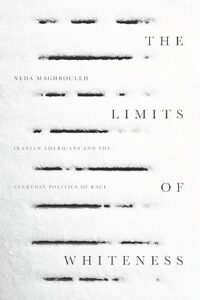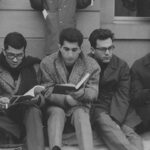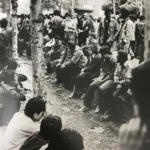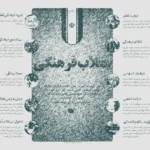/Book Review | Reading Time: 10 minutes
The Limits of Whiteness
Iranian Americans and the Everyday Politics of Race*
Mitra Rastegar | June, 2025
 I had always thought my confusion about my own racial identity had more to do with the light skin and blue eyes I inherited from my white mother than with the fact that my accented, olive-skinned, and “Middle Eastern”-looking father told me that Iranians are considered white. I never believed or internalized the whiteness of Iranians, given the crude circulating images of Iranians and the reactions my own Iranianness elicited from white Americans. Reading Neda Maghbouleh’s The Limits of Whiteness: Iranian Americans and the Everyday Politics of Race, I see that the promise of whiteness has long been held over Iranian Americans who came to desire what they were not allowed to fully inhabit. However, as Maghbouleh documents, a new generation of Iranian Americans, coming of age after 2001, are increasingly rejecting the false call of whiteness to identify with other marginalized communities and forge a new vision of Iranian American identity and politics. Nevertheless, Maghbouleh resists any urge to offer a simplistic understanding of Iranian Americans as “really” non-white. Rather, Maghbouleh’s analysis is consistent with a view of racism as a “scavenger ideology” that opportunistically draws from and aligns with other beliefs and values depending on the specific context (Back and Solomos 1996, 213). By examining the paradoxes of Iranian racial identity, Maghbouleh highlights the complex and contradictory nature of racialization itself.
I had always thought my confusion about my own racial identity had more to do with the light skin and blue eyes I inherited from my white mother than with the fact that my accented, olive-skinned, and “Middle Eastern”-looking father told me that Iranians are considered white. I never believed or internalized the whiteness of Iranians, given the crude circulating images of Iranians and the reactions my own Iranianness elicited from white Americans. Reading Neda Maghbouleh’s The Limits of Whiteness: Iranian Americans and the Everyday Politics of Race, I see that the promise of whiteness has long been held over Iranian Americans who came to desire what they were not allowed to fully inhabit. However, as Maghbouleh documents, a new generation of Iranian Americans, coming of age after 2001, are increasingly rejecting the false call of whiteness to identify with other marginalized communities and forge a new vision of Iranian American identity and politics. Nevertheless, Maghbouleh resists any urge to offer a simplistic understanding of Iranian Americans as “really” non-white. Rather, Maghbouleh’s analysis is consistent with a view of racism as a “scavenger ideology” that opportunistically draws from and aligns with other beliefs and values depending on the specific context (Back and Solomos 1996, 213). By examining the paradoxes of Iranian racial identity, Maghbouleh highlights the complex and contradictory nature of racialization itself.
Over the course of The Limits of Whiteness, Maghbouleh beautifully unravels the intertwining factors that have contributed to deep ambivalence about racial identity among many Iranian Americans. These include 1) historical and official contemporary racial discourses in the US and in Iran that have inconsistently constructed Iranians as white; 2) geopolitical shifts, including the 1979 Iranian Revolution and hostage crisis, and this century’s US-led war on terror, which emboldened conceptions of Iranians as vastly Other; and 3) generational differences among Iranian Americans rooted in these divergent ideologies of race and experiences of racialization.
While Maghbouleh examines the role of state- and media-initiated discourses and practices in the racialization process, the heart of The Limits of Whiteness are quotidian and ground-up processes of race-making. Four central chapters, based on three years of ethnographic work with over 80 young people, examine conflicting racial narratives and experiences that second-generation Iranian Americans encounter at home, in school, in international travel, and at an Iranian American summer camp. Rich with narrative accounts, these chapters also highlight how second-generation Iranian Americans make sense of these contradictions to produce a new understanding of Iranian racial identity. Hence the dynamics Maghbouleh highlights are historical and geopolitical, social and quotidian, and also internal to Iranian American families and communities.
Two different yet related periods of 20th century history form significant, and understudied, backdrops to Maghbouleh’s study of Iranian American quotidian racialization: one in the U.S. and the other (discussed further below) in Iran. Even before the first major wave of Iranians arrived to the US in the 1950s, Maghbouleh shows that Iranians were positioned on the precipice of whiteness, pushed and pulled across the boundary. This ambiguity was evident in cases, as early as 1909, in which West and South Asian immigrants sought to establish their whiteness, a legal prerequisite to US citizenship. Maghbouleh argues that in these cases, Iranians functioned as “racial hinges” where their liminal racial status is “marshaled by a variety of legal and extralegal actors into a symbolic hinge that opens or closes the door to whiteness as necessary” (5). Even as the claimants were not Iranian, Persians were referenced as contrast point, or corollary, to establish the white racial status of the claimant. Maghbouleh’s reading of these contradictory cases demonstrates not only Iranians’ racial ambiguity, but also the incoherence of racial categorizations. While in one case it was a linguistic theory of race that made Iranians, along with the Syrian claimant, white, in another, narratives of religious civilizational conflict cast Iranians as racial others to (Christian) Armenians, designated as white. Although not consistently determinant, Maghbouleh notes that religion “at times both legally and socially functioned as racial or racialized categories for liminal immigrants to the United States.” (30) Moreover, judges did not share a common understanding of the foundation of race—whether ancestral, linguistic, religious or otherwise—and in many cases “common sense” became an acceptable legal basis for racial categories.
While in 1909, a Parsi man was successful in establishing his whiteness through an ancestral connection to Iran, similar reasoning failed in the 1923 case, United States v. Thind. As Maghbouleh describes, Thind, who was from Northern India, claimed to be more white than the Euro-American judges, drawing on logics of racial lineage and purity: “Combining the Aryan myth from Iran with the logic of the caste system in India, Thind built the case that high-caste Indians… were a pure racial group unto themselves within India who maintained strict intermarriage boundaries to ensure that they, as pure, dislocated whites from Persia, never mixed with ‘the dark races of India’” (22). When the judges ruled that Thind was a “brown Hindu” with no racial kinship to the “blond Scandinavian,” they referenced neither ancestral nor linguistic theories, but rather the knowledge of “the average man.” Hence when more “scientific” (although now discredited) theories of race failed, judges leaned on “common sense” to justify the racial hierarchies of a phenotypically-structured society.
While Iranians in the U.S. were officially designated as “white” in 1978, as they still are, Maghbouleh argues that the period since the 1979 Iranian Revolution produced the enduring “browning” of Iranian Americans. Despite scoring highly on classic sociological metrics of assimilation—with high levels of educational and economic privilege and high rates of spatial integration and intermarriage——Iranian Americans are regularly cast as outside acceptable bounds. Indeed, the abrupt and dramatic decline in the status of Iranians in the U.S. following 1979 revolution and hostage crisis speaks to the precarious status of their whiteness. Beginning in the 1950s, the Iranian presence in the U.S. grew exponentially to become the largest international student population. While before the revolution only a minority of Americans (37%) had an unfavorable impression of Iranians, this number rose to an astonishing 91% by 1989, following the revolution, hostage crisis, and Iran-Iraq war (29). In recent years, as Maghbouleh notes, immigrants from the Middle East are deemed the least assimilable of immigrants, and Muslim Americans the most “anti-American” (30), speaking to the racialization of Islam as another contributor to the browning of Iranians (see, e.g., Aziz 2022, Love 2017, Rastegar 2021, Razack 2022, Selod 2018).
Nevertheless, many first-generation Iranian Americans claim whiteness which they link to the status of ancient Persian civilization, a discourse popularized in 20th century Iran. Maghbouleh’s analysis is part of a growing body of scholarship critically examining Iranians’ own racial understandings, such as the works of Reza Zia-Ebrahimi (2016) and Beeta Baghoolizadeh (2024). As Maghbouleh notes, many Iranians arrive in the U.S. with a strongly articulated notion of their own racial and civilizational exceptionalism that is rooted in discourses promoted by the 20th century Pahlavi state. Baghoolizadeh argues that Reza Pahlavi’s project of modernization and Europeanization of Iran required the erasure of Black Iranians, the disavowal of the history slavery in Iran, and a strengthening of a discourse of Iranian whiteness, all in the service of representing Iran as modern to Europeans. Maghbouleh draws on Zia-Ebrahimi’s work to examine the origin and false logic of the notion that Iranians share with Europeans an “Aryan” origin, a concept that originates from the ancient word ariya that designated culturally- and linguistically-linked people from Northern India to Iran. Zia-Ebrahimi uses the term “dislocative nationalism” to describe this construct as seeking to separate Iran from its geographic region. This national and racial discourse strongly distinguishes Iranians from Arabs and from Islam, and imagines a pure racial and cultural lineage that stretches back to ancient Persian civilization, understood as the origin of many great advances of humanity, such as human rights. Persian exceptionalism has parallels to notions of “Western civilization” that draw a straight line to ancient Greek and Roman cultures, erasing the role of Islamic cultures and Muslim philosophers to these intellectual traditions (Appiah 2016). As Appiah argues, these modes of thinking conflate intellectual and cultural production with the everyday lived cultures and values of communities. When applying a racial logic, “culture” is seen as handed down via bloodlines, which then requires the erasure of both cultural and genetic intermixing over millennia. However, unlike the discourse of “Western civilization,” Maghbouleh shows that Persian exceptionalism has often been used as a defense mechanism against denigration, emerging as a component of Iranian modernity in reaction to the traumas of Russian and British military interventionism in the 19th century, and reiterated in response to experiences of bias and exclusion in the U.S. context.
The effects of these internalized discourses of whiteness, in the context of everyday exclusions and violence, are brought into sharp relief in Maghbouleh’s discussion of a 2006 case, Pourgharaishi v. Flying J, Inc. The case revolves around Pourgharaishi’s claim of racial discrimination by a gas station attendant and a security guard. While the horrendous details of the incident make the discrimination claims seem highly plausible, the apparently sympathetic judge feels his hands are tied by the fact that Pourgharaishi insists that he is white and the same race as the people against whom he is bringing the racial discrimination suit. Maghbouleh describes Pourgharaishi’s counter-intuitive testimony as “an accurate reflection of the core paradox of Iranian Americans’ racial status” (34). Despite being objects of animosity and discrimination, Iranians are neither officially recognized as, nor necessarily recognize themselves as, racially marginalized. In other words, while they are deemed too white to be a legally-protected racial group, they are not white enough to avoid discrimination, violence, and policing, speaking to their “ethno-racial invisibility and informal hypervisibility” (3). Maghbouleh coins the concept of “racial loopholes” to describe “the everyday contradictions and conflicts that emerge when a group’s legal racial categorization is inconsistent with its on-the-ground experience of racialization or deracialization” (5).
Second generation Iranian Americans experience a life full of racial loopholes, marked by a stark contrast between their designation as white on official forms, the messages they receive at home, and their everyday experiences in the world and especially at school. Their protective parents’ claims of Persian civilizational greatness and racial kinship with Europeans, seems out of touch with the reality of harassment they regularly encountered by peers and authority figures in schools. As seventeen-year-old Donya describes: “I said to my parents, ‘The kids in my class are making fun of me, and they’re calling me gorilla, making ‘ooh, ooh’ noises. They said Bin Ladin is my dad.’ And my mom said such a typical Iranian parent thing. She goes, ‘Donya joonam [dear], tell them we are the original white people!’” (51). While parents offer narratives of Persian greatness as a salve against the animosity that their children experience, second-generation Iranian Americans know that such narratives have little currency in a country where they are viewed as having the wrong bodies (too hairy) and the wrong lineage (a child of Bin Laden).
The story of Shahram, who is early in his senior year at a new high school speaks to starkness of racism that young people encounter and the connection of this racism to global racial hierarchies. One day, sitting with a couple of friends, he found himself surrounded by twenty or so white athletes verbally assaulting him with racial epithets, including a variation on the n-word. After the crowd was dispersed, Shahram sought to make a complaint, but the Assistant Principal gave him a detention, saying he should be sensitive to how his identity triggers anger in classmates whose family members were serving in the military in Iraq. The example speaks to the twisted racial logic by which a young person is made responsible for global geopolitics, while American soldiers are deemed innocents in need of defense, consistent with Sherene Razack’s (2022) analysis of the affective power and conceptual incoherence of global racial discourses in her more recent book Nothing has to Make Sense. It also speaks to the common conflation of Iranians and Arabs, a conflation that many Iranians would be quick to contest. However Arabs, also categorized as white, are subject to the same racial loopholes that Maghbouleh describes, speaking to the potential of solidarity across these identities, a theme explored later in the book.
The remainder of the book traces the experiences of Iranian Americans in two other realms: international travel and summer camp. Travel to Iran raises many questions of identity, including during transit through airport security where US, Iranian, and other state officials regulate passage based not only on nationality, but also race and gender. Maghbouleh offers a nuanced reading of how young Iranian American men and women must differently manage their bodily comportment to pass through both American and Iranian check-points. A final chapter is on an Iranian American summer camp which offers a space for second-generation Iranian Americans to put their experiences into new analytic frames, including by challenging inherited narratives of Persian exceptionalism. It offers a new vision of Iranian American identity, one that is grounded in the actual lived experiences of second-generation Iranian Americans, and aligns with multiracial politics that sees Iranian Americans’ fates as wrapped up with the fates of other communities of color.
The Limits of Whiteness uses the case of Iranian Americans to analyze the contours of whiteness, the constructedness, flexibility, and even incoherence of race, and its power to shape lives and delimit horizons. It makes important contributions to the scholarship on race and racialization, including within American Studies, Asian American Studies, Whiteness Studies, and the sociology of immigration. As such, Maghbouleh’s book has been important in placing Iranian Diaspora Studies in conversation with a body of scholarship on anti-Muslim and anti-Arab racism, and of race/racism more broadly, while also challenging sociological truisms about the tendency of ethnic immigrants to be assimilated into whiteness. In addition, by examining the role of racial-national discourses brought by immigrants from Iran, Maghbouleh contributes to a growing body of scholarship on racial formations in Iran and the region more broadly. It speaks to the transnational context of divergent and intersecting discourses of race, including whiteness, that originate in European modernity, but travel the globe before they come to heads on the uneven terrain experienced by diasporas in the global North. While making many analytically significant contributions, the book is also a compelling read that has reached non-academic audiences. Through vivid narratives and illustrative examples readers are brought into cultural and political milieus, into complex histories, and especially into the lives of young Iranian Americans. The book is appropriate for undergraduates and accessible to lay audiences, and of particular value to anyone seeking to understand the experiences of the Iranian diaspora. The book beautifully weaves together analysis and narrative to demonstrate the complex dynamics of race-making, and how it is encountered individually and collectively, providing important insight toward a transformative politics that is more necessary today than ever.
* Author’s note: This is an expanded version of a review essay originally published in Ethnic Studies Review, University of California Press Journals, Jul 1, 2023
Works Cited
Appiah, Kwame Anthony. “There is no such thing as Western civilization,” The Guardian, Nov. 9. https://www.theguardian.com/world/2016/nov/09/western-civilisation-appiah-reith-lecture.
Aziz, Sahar F. The Racial Muslim: When Racism Quashes Religious Freedom. Oakland, California: University of California Press, 2022.
Back, Les, and John Solomos. Racism and Society, Macmillan Education, Limited, 1996.
Baghoolizadeh, Beeta. The Color Black: Enslavement and Erasure in Iran. Durham: Duke University Press, 2024.
Love, Erik. Islamophobia and Racism in America. New York: New York University Press, 2017.
Rastegar, Mitra. Tolerance and Risk: How U.S. Liberalism Racializes Muslims. Minneapolis, MN: University of Minnesota Press, 2021.
Razack, Sherene. Nothing Has to Make Sense: Upholding White Supremacy through Anti-Muslim Racism. Minneapolis, MN: University of Minnesota Press, 2022.
Selod, Saher. Forever Suspect: Racialized Surveillance of Muslim Americans in the War on Terror. New Brunswick, New Jersey: Rutgers University Press, 2018.
Zia-Ebrahimi, Reza. The Emergence of Iranian Nationalism: Race and the Politics of Dislocation. New York: Columbia University Press, 2016.










Comments are closed.